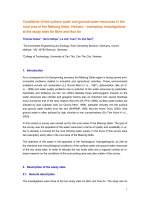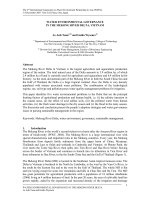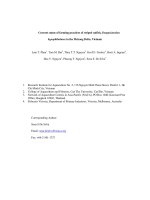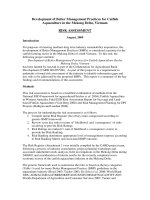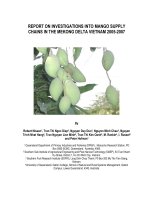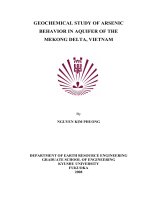Market information transfer system (MITS) in the rice value chain in the Mekong delta, Vietnam
Bạn đang xem bản rút gọn của tài liệu. Xem và tải ngay bản đầy đủ của tài liệu tại đây (242.96 KB, 6 trang )
Journal of Vietnam Agricultural Science and Technology - No.1(3)/2018
rice production in Vietnam. Institute for Agricultural
Enviroment, Hanoi (in Vietnamese).
Tran Viet Cuong, 2010. Report “Study on production
of biochar from agricultural waste in the Mekong
Delta”. Institute for Agriculture Environment (IAE)
(in Vietnamese).
World Bank, 2004. Economic growth, poverty, and
household welfare in Vietnam. In P. A. Glewwe &
D. Dollar (Eds.), Regional and Sectoral Studies
(pp. 1-628): e World Bank Group. Retrieved from
/>bf31e41a46f3c4accda97cac.
Date received: 2/12/2018
Date reviewed: 7/12/2018
Reviewer: Ass. Prof. Dr. Pham Quang Ha
Date approved for publication: 21/12/2018
MARKET INFORMATION TRANSFER SYSTEM (MITS)
IN THE RICE VALUE CHAIN IN THE MEKONG DELTA, VIETNAM
Pham Cong Nghiep*1, Vu Van Doan1
Abstract
e research in the world indicated that MITS considerably in uenced farmers’ production and trade, it increased the
e ciency of agricultural production, the income of farmers and improved the living condition of farmers. However,
studying and applying MITS in the reality in the Mekong delta of Vietnam were still limited. is paper will analyze
the current situation of MITS in the rice value chain in the Mekong delta, Vietnam from 315 farmers’ survey in 2017.
e ndings of the survey showed that: Majority of rice farmers in the Mekong delta of Vietnam have been accessing
to market information from many sources such as relatives, friends, village leaders, traders, collectors, agricultural
extension system, television, etc and through some channels face-to-face meetings, phone, television, radio, etc.
Rice farmers’ satisfaction on MITS was still low because they have met some obstacles during market information
seeking and usage such as low quality of market information, lack of market information sources and channels, lack
of governmental agencies participation in MITS, etc. Rice farmers’ educational level, household size, rice income and
amount of market information channels had a signi cant in uence on farmers’ satisfaction on MITS in rice value
chain in the Mekong delta, Vietnam.
Keywords: Market information transfer system, market information sources, market information channels, Mekong
delta, rice value chain
INTRODUCTION
Rice plays an important role in Vietnamese life and
economy. According to Do i u Ha (2012) rice
subsector was occupying 40% of gross output of
Vietnamese agriculture, 9.3 million households were
planting paddy (65% of rural households). During the
period of 2010 to 2017, Vietnam averagely exported
6.06 million tons of rice with its value of 2.609 billion
USD annually (General Statistics O ce, 2017).
e Mekong delta is rice granary in Vietnam. is
region contributes up to 50% of national rice output
and 90% of rice export. However, the main issues in
rice sector in the Mekong delta is low pro t of rice
farmers. According to a study of Tran Cong ang
et al. (2013) showed that the average income of rice
farmers from rice production in the Mekong delta
was very low with 535,000 VND/month (about
25 USD/month).
1
*
Market information system plays an important role
in raising the e ciency of economic performance
and helps farmers enter the market better, sell more
products with higher prices (Sultan Freihat, 2012).
e demand of improving the market information
system is imperative and a great signi cant to
rice farmers in the Mekong delta, Vietnam.
e
competitive pressure of rice farmers in the Mekong
delta is more and more growing because with the
development of science and technology, they have
produced more and more the rice output, many rice
farmers need to sell a bigger amount at the same time
and so they need to nd out the larger markets to
sell the more rice with higher price. ere are more
and more intermediates between rice farmers and
nal customers and export companies in the Mekong
delta and these intermediates became a barrier for
the market information ow in the rice value chain,
Center for Agrarian Systems Research and Development - Food Crops Research Institute
Corresponding author: Pham Cong Nghiep. Email:
93
Vietnam Academy of Agricultural Sciences (VAAS)
even they can distort the market information to get
advantages in the bargain, to make a wider gap of
market information between participants in the rice
value chain. erefore, this my research will help us
have a clear insight about the current MITS in the
rice value chain in the Mekong delta, Vietnam in
order to propose a model of MITS that is suitable
in Vietnamese condition, a developing country, low
income, weak infrastructure.
50 farmers per district in Can o and 55 farmers
per district in An Giang were randomly chosen to
interview. e sample total is 315 respondents.
RESEARCH GOALS, OBJECTIVES AND METHODS
SPSS was used for all statistical analyses and the data
was entered into SPSS. Wrong and missing data were
veri ed with the original questionnaires.
Research goals and objectives
Research goals
- Identify the rice market information sources
and channels of rice farmers in the Mekong delta,
Vietnam.
- Evaluate the usage of rice market information
accessed by rice farmers in the Mekong delta,
Vietnam.
- Determine the factors that in uence rice farmers’
satisfaction of MITS in the Mekong delta, Vietnam.
Objectives of the study
Methods to collect the data
e qualitative and quantitative data were collected
by questionnaire. e number of questionnaires was
315 and each of them lasted about 45 minutes.
Data analysis
Descriptive statistics (frequencies, percentages,
means) were used to present the variables.
Binary Logistic model was used to identify the socioeconomic characteristics of rice farmers in uencing
on farmers’ satisfaction about MITS in the Mekong
delta, Vietnam.
Model speci cation:
Y = log [P/1-P] = logY = α +β1X1+β2X2+β3X3 +
β4X4 +β5X5 +β6X6 +β7X7 +µ
Methods of the study
Where Y = Market information satisfaction; β = Regression
coe cient explaining changes caused in Y by changes
in the independent variables; Market information
satisfaction = 1, Market information unsatisfaction = 0;
X1 = Age (in years) of the respondents; X2 = Gender of
the respondents (0 = Female; 1 = Male); X3 = Education
level (Years); X4 = Household size (amount of people);
X5 = Rice income (Million VND); X6 = Amount
of market information channels; X7 = Amount of
market information sources; µ = Error term.
Process of sample choice
Time and place of the study
To provide the general of picture of MITS to all actors
in the rice value chain in the Mekong delta, Vietnam,
to managers and policy-makers. On that basic, all
actors in the rice value chain will build their own
plan to meet their demands of market information,
help managers and policy-makers have the science
basic for making decisions, policies related to MITS
in Vietnam.
An Giang province and Can o City were chosen
as a research area in this survey because An Giang
province is a top rice producer in the Mekong delta
and Can o city is an economic, political and social
center but also has the most rice traders, export
companies in the Mekong delta.
This study was carried out from September 10th to
October 6th 2017 in An Giang province and Can
Tho city.
anks to advice of leader of Agricultural Extensions
Center and the statistical data about rice production
area, 3 districts per province were chosen to survey,
in which there is a district with a large area of rice
production, a district with medium area of rice
production and a district with a small area of rice
production. In An Giang, 3 districts were surveyed:
Chau Phu, oai Son and Cho Moi. In Can o, those
3 districts are oi Lai, O Mon and Phong Dien.
Socio-economic characteristics may in uence on the
e ect of rice production and of market information
usage of rice farmers. Table 1 presents the socioeconomic characteristics of the respondents.
94
RESULTS AND DISCUSSION
Socio-economic characteristics of respondents
Age: e mean age of the respondents was 47 years.
Majority of the respondents (30.5%) were between
41 and 50 years of age. ose at this age were usually
family heads, they decided mainly in rice production
and trade of their family.
Journal of Vietnam Agricultural Science and Technology - No.1(3)/2018
Gender: Gender can a ect the decision in rice
production and trade of their family. In a Vietnamese
family, the husband has a bigger voice in almost
activities of their family. In the sample, male occupies
74%, higher than female (26%).
Educational level: Educational level of rice farmers
will in uence on their market information access,
analysis and usage. 43.2% of respondents were
students in high schools, 42.5% of respondents were
students in secondary schools and the remainder
(14.3%) was pupils in primary schools. is infers
that respondents have an ability to understand and
use market information.
Household size: Household size may impact the e ect
of market information seeking. Big families have more
and more opportunities to seek good information. An
average size of a respondent’s family was 5 people, in
which 33% of sample had 4 people, 5 people families
seized 24.4%, 16.2% of respondents were 6 people
family, 14.3% were 3 people family, over 6 people
families held 8.6% and 2 people families were 3.5%.
Rice income of rice producers: Rice income of rice
farmers can in uence on their market information
seeking and usage. Rice farmers with a higher rice
income have an ability to search and use in more
e ective way.
e average income from rice of
respondents was 70.9 million VND/year (about
3,200 USD/year), equivalently 53% of the total
income of a rice household. It means that rice has an
important role in rice household economy.
Table 1. Socio-economic characteristics
of the respondents
Variables
Mean
Age (years)
47
Educational level (grade)
9
Family size (people)
5
Rice income (million VND)
70.9
Source: Authors survey, 2017.
Rice farmers’ satisfaction level on MITS in the rice
value chain
Farmers’ satisfaction level on market information
system is an important norm that re ects the gap
between the farmers’ needs of market information
and the meeting of the market information system
to those needs. e high satisfaction infers that the
market information system has been running well
and the contrary. e data from table 2 shows that
rice farmers’ satisfaction on market information
system was not high. 38.1% of respondents had a
low satisfaction and 14% of respondents were at
very low level, meanwhile only 13% of respondents
had a high satisfaction and 0.6% were at very high
satisfaction. ere are many reasons for low farmers’
satisfaction on market information systems such as
lack of market information sources and channels, low
quality of market information, etc and these reasons
will be analysis in the next parts of this research.
Table 2. Rice farmers’ satisfaction level
on market information system
Satisfaction level
Frequency
Percent
Very low
44
14.0
Low
120
38.1
1,108
34.3
High
41
13.0
Very high
2
0.6
315
100
Medium
Total
Source: Own survey, 2017.
Market information sources
e market information sources e ect considerably
on the quality of market information farmers’ access.
Figure 1 indicates that 100% of respondents have been
accessing to market information from other farmers,
relatives and friends. e next source is traders. 99%
of respondents approached market information from
collectors who bought directly rice from farmers,
91% said that they gained market information from
big traders. Village leaders were an important source
for rice farmers when 70% accessed to village leaders
to get market information, 64% used television to
gain market information, the agricultural extension
system provided market information to 34% of
respondents. In addition, there are other sources of
market information such as rice farmer organizations
(11%), newspapers (4%), radio (8%), Internet (10),
other governmental agencies (6%).
Rice farmers in the Mekong delta, Vietnam are passive
to access to market information sources, they mainly
got market information from informal sources with a
low quality of market information.
95
Vietnam Academy of Agricultural Sciences (VAAS)
Figure 1. Market information sources used by rice farmers in the Mekong delta (%)
Source: Authors survey, 2017
Market information channels
Market information channel is a very important
element in MITS. It in uences on the market
information quality, information dissemination
speed, amount of market information receivers
(Asogwa B. C., O. Abu and M. A. Onkpe, 2014). A
good channel of market information is a channel with
a fast speed of information dissemination, a low cost
and a big amount of users.
Figure 2 indicates that 100% of rice farmers in the
Mekong delta have been using face-to-face meetings
to get market information, 95% of respondents used
phones to access to market information, 67% watched
televisions to approach market information at harvest
time, 37% listened loudspeakers to gain market
information. In addition, 10% used internet to follow
market information, 8% of respondents listened radio
and 4% read newspapers to get market information.
Figure 2. Market information channels used by rice farmers in the Mekong delta (%)
Source: Authors survey, 2017.
Socio-economic characteristics in uence on rice
farmers’ satisfaction on MITS
e output of Binary Logistic model in table 3
shows that the signi cant level of the model (Sig.)
96
is high (0.000), the percentage correct of the model
is 86%.
erefore, the model is acceptable and is
used to identify factors in uencing on rice farmers’
satisfaction on MITS.
Journal of Vietnam Agricultural Science and Technology - No.1(3)/2018
e data in table 3 shows that at 5% level of
signi cance, educational level, rice income and
amount of market information channels signi cantly
impacted on rice farmers’ satisfaction on MITS and
the rest factors (age, farmer organization member,
amount of market information sources) didn’t have
signi cant in uences.
e educational level of respondents had a signi cant
and positive in uence on rice farmers’ satisfaction on
MITS (B = 0.166; Sig. = 0.040) at a signi cant level of
5%. is suggests that higher and higher educational
level of respondents more and more considerable
their satisfaction on MITS. It can be inferred from this
that rice farmers with a high educational level had a
signi cant ability to seek and use market information
in an e ective way.
Rice income had a signi cant in uence on rice
farmers’ satisfaction of MITS (B = 0.019; Sig. = 0.012)
at a signi cant level of 5%. is asserts that respondents
with a higher rice income had a higher satisfaction of
MITS than rice producers who lower rice income. In
fact, rice producers with a large area of rice production,
a big output of rice and a high income from rice had
o en high demands of market information and they
were also active to seek market information to get
better information.
e amount of market information channels also
signi cantly and positively in uenced the rice
producers’ satisfaction of MITS (B = 1.405; Sig. = 0.000)
at a signi cant level of 5%. It has been inferred that
rice farmers with more and more channels of market
information had more and more satisfaction of MITS.
Rice farmers with many market information channels
were convenient to gain market information and had
many chances to access to good market information.
Table 3. Socio-economic characteristics
in uence rice farmers’ satisfaction on MITS
Variables
B
S.E. Wald df Sig.
Age
.031 .021 2.095
1 .148
Educational level .166 .081 4.226
1 .040*
Rice income
.019 .008 6.366
1 .012*
Channel amount 1.405 .309 20.623 1 .000*
Source amount
–.036 .208 .030
1 .862
FO member
.135 .614 .049
1 .825
Constant
–8.606 2.414 12.710 1 .000
N = 315; Sig = 0.000; -2 Log likelihood = 187.100
Nagelkerke R Square = 0.349; Percentage correct = 86%
Note: * e statistic is signi cant at 5% level.
Source: Authors survey, 2017.
CONCLUSIONS
Majority of rice farmers in the Mekong delta,
Vietnam have been accessing to market information
from many sources such as relatives, friends, village
leaders, traders, collectors, agricultural extension
system, television, etc and through some channels
face-to-face meetings, phone, etc. However, rice
farmers’ satisfaction on market information system
was still low because they have met some obstacles
during market information seeking and usage
such as low quality of market information, lack of
market information sources and channels, lack of
governmental agencies participation in MITS, etc.
Besides, the research also indicated that rice farmers’
educational level, household size, rice income and
amount of market information channels had a
signi cant in uence on farmers’ satisfaction on MITS
in rice value chain in the Mekong delta, Vietnam.
REFERENCES
Asogwa B. C., O. Abu and M. A. Onkpe, 2014.
Marketing Information Usage among Rice Producers
in Benue State, Nigeria. Asian Journal of Agricultural
Extension, Economics
Sociology, 3 (5): 427-444,
2014; Article No. AJAEES.2014.5.005.
Do Thi Thu Ha, 2012. Production survey of paddy
in Vietnam. Accessed on 8/9/2018; available from:
/>ess_test_folder/Workshops_Events/APCAS_24/
PPT_after /AP CAS-12-2 0-Rice_Production_
Viet_Nam.pdf.
General Statistics O ce, 2017. Statistical summary book
of Vietnam. Available from: />default.aspx?tabid=384&idmid=&ItemID=18938;
accessed on 29/9/2018.
Sultan Freihat, 2012. e role of marketing information
system in marketing decision-making in Jordanian
shareholding medicines production companies.
IJRRAS 11 (2). May 2012. www.arpapress.com/
Volumes/Vol11Issue2 /I JRR AS_1 1_2_18.pdf;
accessed on March 27, 2018.
Tran Cong ang, Do Lien Huong, Le Nguyet Minh,
2013. Policy dra : Who bene ts when the rice price
increase?
/>media/files/who-benefits-rice-prices-vietnamfull-20131017.pdf; accessed on March 25, 2018.
Date received: 11/10/2018
Date reviewed: 19/10/2018
Reviewer: Assoc. Dr. Doan Manh Tuong
Date approved for publication: 21/12/2018
97
Vietnam Academy of Agricultural Sciences (VAAS)
STUDY ON THE CURRENT SITUATION OF SUPPLY CHAIN FOR MANGO
PRODUCTION IN CAM LAM DISTRICT - KHANH HOA PROVINCE
Nguyen Tan Hung1, Ho Huy Cuong1, Do i Ngoc1,
Pham Vu Bao , Tran Quoc Dat1, Nguyen i Hang Ni1, Nguyen Phi Hung2
*1
Abstract
To stabilize and improve the income of local mango producers, a study on current status of mango distribution
was carried out in Khanh Hoa province from 2014 - 2015. Results showed that 3 di erent supply chains have been
available in mango production in the location, including (1) from the producers retailers consumers (7.5 - 7.7%);
(2) from the producers Business owner whole sale markets retailers consumers (92.3 - 92.5%); (3) from the
producers business owner export to China (47.3%). In case of Cam Lam district, mango producers bring their
products directly to the collecting places (producers business owner), they can bene t much better since it has
reduced the intermediate steps. As a matter of fact, the income distribution between producers and collectors was not
transparent; ununiformed and unsafe products are still big problems. Because of that, the establishment of mango
production cooperatives in which farmers have to produce high quality and safe products should be accordingly
recommended.
Keywords: Cam Lam mango, mango status, value chain of mango
INTRODUCTION
Methods
Mango is considered as the main crop of Khanh Hoa
province with 6,042 - 6,467 ha under cultivation in
2012 - 2016 period that produces 40,899 - 41,582
tons/year and earns 400 - 450 billion VND. Cam Lam
is mostly concentrated location of mango production
accounting for approximately 50% of the total area
and production in whole province (from 2012 - 2016,
mango area varied from 2,830 - 3,120 ha with the
uctuated production from 22,952 - 24,828 tons/year)
(Khanh Hoa Statistical Yearbook, 2017). It is
especially mentioned that in recent years, mango
cultivation in Cam Lam district has been gradually
shi ed from small-scale production with many
cultivars to large scale one focusing on the three main
cultivars as Canh Nong, Cat Hoa Loc and Australia
mango (R2E2). ough lots of advantages in mango
production have been achieved,, the unsustainable
income of mango producers in Cam Lam district is
also regarded as a main issue that must be accordingly
solved to nd out appropriate solution for successful
improvement the situation.
Methods used: Data and information concerned
were collected by relevant persons and agencies in
combination with the review conducted from 64
retailers and business owner, and 31 farmers.
OBJECTIVES AND METHODS
ough lots of mango cultivars have been available
in the location studied (Canh Nong, Cat Bo Trang,
Cat Bo Vang, Cat Hoa Loc, Cat Chu, R2E2, Taiwan,
ailand etc.), main demand was concentrated on
three leading cultivars, says, Canh Nong, Cat Hoa
Loc and Australian mango (81.3%, 82.8% and 85.9%,
respectively) (Table 1).
Objectives
e aims of the survey was to assess the strengths and
weaknesses of the current status of mango distribution
in order to nd out solutions for improvement of
mango production in Khanh Hoa province.
1
*
Survey content: Production chains of mango inside
and outside of province; Mango sorting levels in
production and harvesting for the three cultivars;
Method and capacity of mango growers in product
collecting, sorting and preserving; Price uctuations
in the mango crop and between sorting levels; Main
di culties faced to local producers in terms of
production and consumption.
Data and information collected were then analyzed
with the support of Excel program in collaboration
with SWOT method (Humphrey, Albert, 2005).
Time and place of the study
e study was implemented in 2014 - 2015 period in
Cam Lam district Khanh Hoa province.
RESULTS AND DISCUSSION
Current status of mango value chain in Cam Lam
Agricultural Science Institute for Southern Costal Central of Vietnam; 2 University of Da Nang
Corresponding author: Pham Vu Bao. Email:
98


